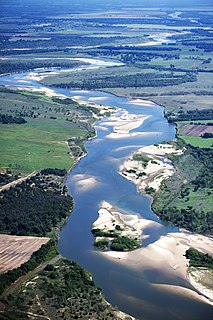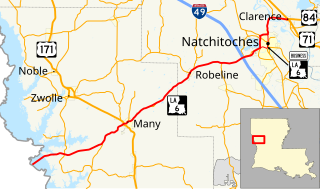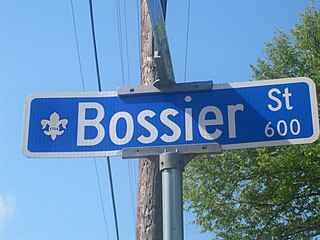See also
- Cane (disambiguation)
- Cane River Lake, a lake formed from a portion of the Red River in Natchitoches Parish, Louisiana
- Cane Creek (disambiguation)
Cane River is a river formed from a portion of the Red River that is located in Natchitoches Parish, Louisiana, United States.
Cane River may also refer to:
Jackson may refer to:
Red River usually refers to one of the following:

Sabine Parish is a parish located in the U.S. state of Louisiana. As of the 2010 census, the population was 24,233. The seat of the parish is Many.

Natchitoches Parish is a parish located in the U.S. state of Louisiana. As of the 2010 census, the population was 39,566. The parish seat is Natchitoches. The parish was formed in 1805.

Bossier City is a city in Bossier Parish in the northwestern region of the U.S. state of Louisiana in the United States. It is the second most populous city in the Shreveport–Bossier City metropolitan statistical area. In 2020 it had a total population of 62,701 up from 61,315 in 2010. It is on the eastern bank of the Red River and closely tied economically and socially to its larger sister city Shreveport on the opposite bank. Bossier City is the largest city in Louisiana that is not the parish seat.

Natchitoches is a small city and the parish seat of Natchitoches Parish, Louisiana, United States. Established in 1714 by Louis Juchereau de St. Denis as part of French Louisiana, the community was named after the indigenous Natchitoches people.

The Red River, or sometimes the Red River of the South, is a major river in the Southern United States. It was named for its reddish water color from passing through red-bed country in its watershed. It is one of several rivers with that name. Although once a tributary of the Mississippi River, the Red River is now a tributary of the Atchafalaya River, a distributary of the Mississippi that flows separately into the Gulf of Mexico. This confluence is connected to the Mississippi River by the Old River Control Structure.

North Louisiana, also known locally as Sportsman's Paradise, is a region in the U.S. state of Louisiana. The region has two metropolitan areas: Shreveport-Bossier City and Monroe-West Monroe; the Shreveport area is the largest metropolitan area by population in North Louisiana.

Cane River Lake is a 35 mi (56 km) oxbow lake formed from a portion of the Red River in Natchitoches Parish, Louisiana, United States. It runs throughout the Natchitoches' historic district to the south and is famous for the numerous plantations, particularly Melrose being located on or near its banks.

Established in 1994, the Cane River Creole National Historical Park serves to preserve the resources and cultural landscapes of the Cane River region in Natchitoches Parish, Louisiana. Located along the Cane River Lake, the park is approximately 63 acres and includes two French Creole cotton plantations, Oakland and Magnolia. Both plantations are complete in their historic settings, including landscapes, outbuildings, structures, furnishings, and artifacts; and they are the most intact French Creole cotton plantations in the United States. In total, 65 historic structures and over a million artifacts enhance the National Park Service mission as it strives to tell the story of the evolution of plantation agriculture through the perspective of the land owners, enslaved workers, overseers, skilled workers, and tenant farmers who resided along the Cane River for over two hundred years. This park is included as a site on the Louisiana African American Heritage Trail.
Marie Thérèse Coincoin,^ born as Coincoin, also known as Marie Thérèse dite Coincoin, and Marie Thérèse Métoyer, she was a planter, slave owner, and businesswoman at the colonial Louisiana outpost of Natchitoches.

Louisiana Highway 6 (LA 6) is a state highway located in western central Louisiana. It runs 54.52 miles (87.74 km) in an east–west direction from the Texas state line southwest of Many to U.S. Highway 71 (US 71) and U.S. Highway 84 (US 84) in Clarence.

Pierre Evariste Jean-Baptiste Bossier was a planter, soldier and politician born in Natchitoches, Louisiana. He is the namesake of Bossier Parish, located east of the Red River across from Shreveport in northwestern Louisiana. Bossier City and the Pierre Bossier Mall shopping center in Bossier City are among the other places named for him.

Cloutierville is an unincorporated community in Natchitoches Parish, Louisiana, United States. It lies approximately 20 miles (32 km) south of the city of Natchitoches on the Cane River. The community is part of the Natchitoches Micropolitan Statistical Area, off exit 119 of Interstate 49.
The Natchitoches are a Native American tribe from Louisiana. They organized themselves in one of the three Caddo-speaking confederacies along with the Hasinai, and Kadohadacho.
Oakland Plantation may refer to:

Melrose Plantation, also known as Yucca Plantation, is a National Historic Landmark located in the unincorporated community of Melrose in Natchitoches Parish in north central Louisiana. This is one of the largest plantations in the United States built by and for free blacks. The land was granted to Louis Metoyer, who had the "Big House" built beginning about 1832. He was a son of Marie Therese Coincoin, a former slave who became a wealthy businesswoman in the area, and Claude Thomas Pierre Métoyer. The house was completed in 1833 after Louis' death by his son Jean Baptiste Louis Metoyer. The Metoyers were free people of color for four generations before the American Civil War.

St. Augustine Catholic Church and Cemetery, or the Isle Brevelle church, is a historic Roman Catholic church and cemetery located in Melrose, Natchitoches Parish, Louisiana. It is the cultural center of Cane River's historic Créoles of color community.

The Red River National Wildlife Refuge is a preservation project which will ultimately consist of approximately 50,000 acres (200 km2) of United States federal lands and water along that section of the Red River between Colfax in Grant Parish, Louisiana, and the Arkansas state line, a distance of approximately 120 miles (190 km). Currently the refuge has acquired approximately 16,000 acres (65 km2) of the proposed 50,000 acres (200 km2).